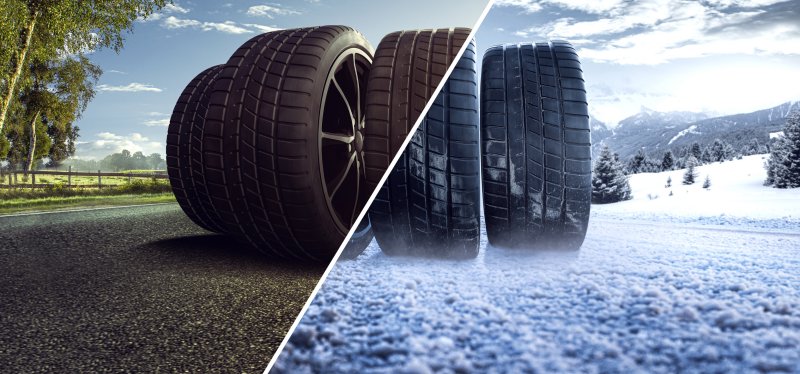
As autumn's vibrant palette begins to fade and the crispness in the air hints at colder days, a critical question invariably emerges for responsible motorists: "When should I switch to winter tires?" This isn't merely a logistical query but a profound safety decision, impacting vehicle performance, driver confidence, and the well-being of everyone on the road. While the impulse might be to wait for the first snowflake, a proactive, informed approach, grounded in meteorology, material science, and personal driving habits, is paramount. This comprehensive guide delves into the multifaceted considerations that define the optimal window for your annual tire transition.
The Cornerstone: The 7°C Threshold
At the heart of the winter tire debate lies a foundational principle: the 7-degree Celsius (45-degree Fahrenheit) rule. This isn't an arbitrary figure but a scientifically derived benchmark signalling a fundamental shift in tire performance. Conventional all-season tires, designed for a broad range of temperatures, begin to harden and lose their elasticity as temperatures consistently dip below this threshold. This hardening directly translates to reduced grip, diminished braking performance, and compromised handling, even on dry pavement.
Winter tires, by contrast, are engineered with a specialized rubber compound that remains flexible and pliable in cold conditions, often incorporating a higher silica content. This unique molecular structure allows them to conform better to the road surface, providing superior traction. Furthermore, winter tires feature distinct tread patterns – deeper grooves and thousands of microscopic cuts called sipes – which are specifically designed to evacuate slush, bite into snow, and grip ice. Below 7°C, the performance gap between winter and all-season tires widens dramatically, making the former an indispensable safety component. It’s crucial to understand that this rule applies regardless of whether snow is present; the cold asphalt itself fundamentally alters how your tires interact with the road.
Beyond Temperature: A Holistic Assessment
While the 7°C rule serves as an excellent starting point, a truly comprehensive decision requires a holistic assessment of several additional factors.
1. Geographic Location and Microclimates
The "when" for Newfoundlanders, for instance, will differ significantly from that of British Columbians in Victoria, or even those in the interior of B.C. Mountainous regions experience colder temperatures and more rapid weather changes, often receiving earlier and heavier snowfall. Coastal areas, while generally milder, can still be prone to sudden freezing rain and black ice. Therefore, understanding your specific regional climate and any unique microclimates along your usual driving routes is critical. If you live in an area known for sudden, severe winter weather, an earlier switch is a prudent preventative measure.
2. Anticipated Weather Patterns and Forecasts
Relying solely on historical averages can be misleading. Modern meteorological forecasting offers valuable insights into impending weather shifts. Regularly monitoring long-range forecasts from reliable sources in late autumn can help you pinpoint the week or even day when temperatures are expected to consistently drop below 7°C. Being proactive means avoiding the rush and potential hazards of an unexpected early cold snap or snowfall. Don't wait for snow to fall; predict when the conditions will require winter tires.
3. Personal Driving Habits and Commute
Your daily driving routine plays a significant role in determining when to switch. If your commute involves highways, rural roads, or areas known for shade and moisture retention (which can lead to black ice), the need for winter tires becomes more urgent. Drivers who frequently travel during early mornings or late evenings, when temperatures are lowest, will benefit from the enhanced grip of winter tires sooner than those who primarily drive during warmer daylight hours. Similarly, if you plan to undertake long-distance winter travel to areas with harsher climates, switching ahead of your trip is non-negotiable. More aggressive drivers or those with a penchant for spirited driving should also consider the enhanced safety margin earlier.
4. Type of Vehicle and Traction Systems
While modern vehicles equipped with All-Wheel Drive (AWD) or Four-Wheel Drive (4WD) offer superior traction for acceleration in slippery conditions, it's a common misconception that they negate the need for winter tires. AWD systems are invaluable for getting unstuck or moving from a standstill, but they do not improve braking or cornering on ice or snow. Braking and steering depend solely on the grip provided by the tires at each wheel. A heavy SUV with AWD on all-season tires will still struggle to stop or turn safely on icy roads, whereas a compact front-wheel-drive car equipped with proper winter tires will often outperform it in these critical safety aspects.
5. Condition of Existing Tires
Even if you're running all-season tires, their effectiveness in colder temperatures is heavily dependent on their tread depth. As all-season tires wear down, their ability to channel water and slush, and provide grip on cold surfaces, diminishes significantly. If your all-season tires are nearing their wear indicators (typically 4/32nds of an inch for winter performance, though legally 2/32nds in many places), their cold-weather performance will be severely compromised, urging an earlier switch to dedicated winter tires.
6. Differentiating Tire Types: Winter vs. All-Season vs. All-Weather
It's crucial to understand the distinct roles of various tire categories.
- All-Season Tires: Designed for general use, suitable for mild winters but compromise performance in severe cold, snow, and ice. Their rubber hardens below 7°C.
- All-Weather Tires: A newer category, denoted by the "3 Peak Mountain Snowflake" (3PMSF) symbol, offering better cold-weather and light snow performance than all-seasons. They are a good compromise for regions with moderate winters. However, they still don't match the dedicated performance of true winter tires in harsh conditions.
- Winter Tires: Specifically engineered for cold temperatures (below 7°C), heavy snow, and ice, identified by the 3PMSF symbol. They offer the best grip, braking, and handling in severe winter conditions.
If you rely on traditional all-season tires, the 7°C rule is even more critical. If you have all-weather tires, you may have a slightly longer grace period, but a dedicated winter tire will always provide a superior safety margin when temperatures consistently drop.
The Double-Edged Sword: The Perils of Too Early or Too Late
Switching Too Early:
While safety is paramount, there's a delicate balance. Installing winter tires when temperatures are still consistently above 7°C can lead to:
- Accelerated Wear: The softer compound of winter tires wears much faster on warm, dry pavement, reducing their lifespan.
- Reduced Performance: Their softer tread and aggressive patterns can lead to slightly less precise handling, increased road noise, and marginally higher fuel consumption in warmer conditions.
- Cost Implications: Premature wear means replacing tires more frequently, incurring higher costs.
Switching Too Late:
The consequences of delaying the switch are far more severe:
- Compromised Safety: The most critical risk is reduced braking distance and loss of control in unexpected early snow, ice, or freezing rain. This significantly increases the risk of accidents.
- Logistical Headaches: Everyone rushes to tire shops after the first snowfall, leading to long wait times, appointment backlogs, and potential scarcity of specific tire sizes.
- Stress and Convenience: Being caught unprepared can be stressful and inconvenient, potentially forcing you to drive on unsafe roads or delay important travel.
Crafting Your Personalized Winter Tire Strategy
The optimal time to switch to winter tires is not a fixed date on the calendar, but rather a dynamic decision based on a careful synthesis of the factors discussed. A proactive approach involves:
- Late October to Mid-November: This general window often aligns with the consistent drop below 7°C in many temperate regions. For northern, mountainous, or historically colder areas, early to mid-October might be more appropriate.
- Monitor Forecasts: Beyond the general window, keep a close eye on 7-10 day weather forecasts starting in early October. Look for multi-day trends of temperatures consistently below 7°C, especially morning lows.
- Consider Your "Worst Case" Scenario: If even a single unexpected cold snap or dusting of snow could severely impact your commute or safety, err on the side of caution and switch earlier.
Practical Steps for a Smooth Transition
Once you've determined your optimal timing, ensure a seamless transition:
- Book Early: Schedule your tire change appointment well in advance to avoid the inevitable rush.
- Inspect Your Winter Tires: Before installation, check the tread depth, sidewall condition, and age of your winter tires. If they are over 6-7 years old or have significantly worn tread (below 5/32nds of an inch for optimal winter performance), consider replacing them.
- Proper Storage: Store your off-season tires correctly – clean, dry, and away from direct sunlight, ideally stacked on their side or hung, to prolong their life.
- Post-Installation Check: After installation, ensure your tire pressure is correctly set according to your vehicle manufacturer's specifications. New tires, especially, may require a re-torque of lug nuts after 50-100 km.
Conclusion
Switching to winter tires is more than a seasonal chore; it is an intelligent investment in safety, confidence, and peace of mind during the challenging colder months. By understanding the scientific basis of the 7°C rule and assessing your unique driving context, you can pinpoint the ideal moment to make this crucial transition. Don't be reactive to the first signs of winter; be proactive, informed, and prepared. Your safety, and the safety of those around you, depends on it.







0 Comments
Post Comment
You will need to Login or Register to comment on this post!